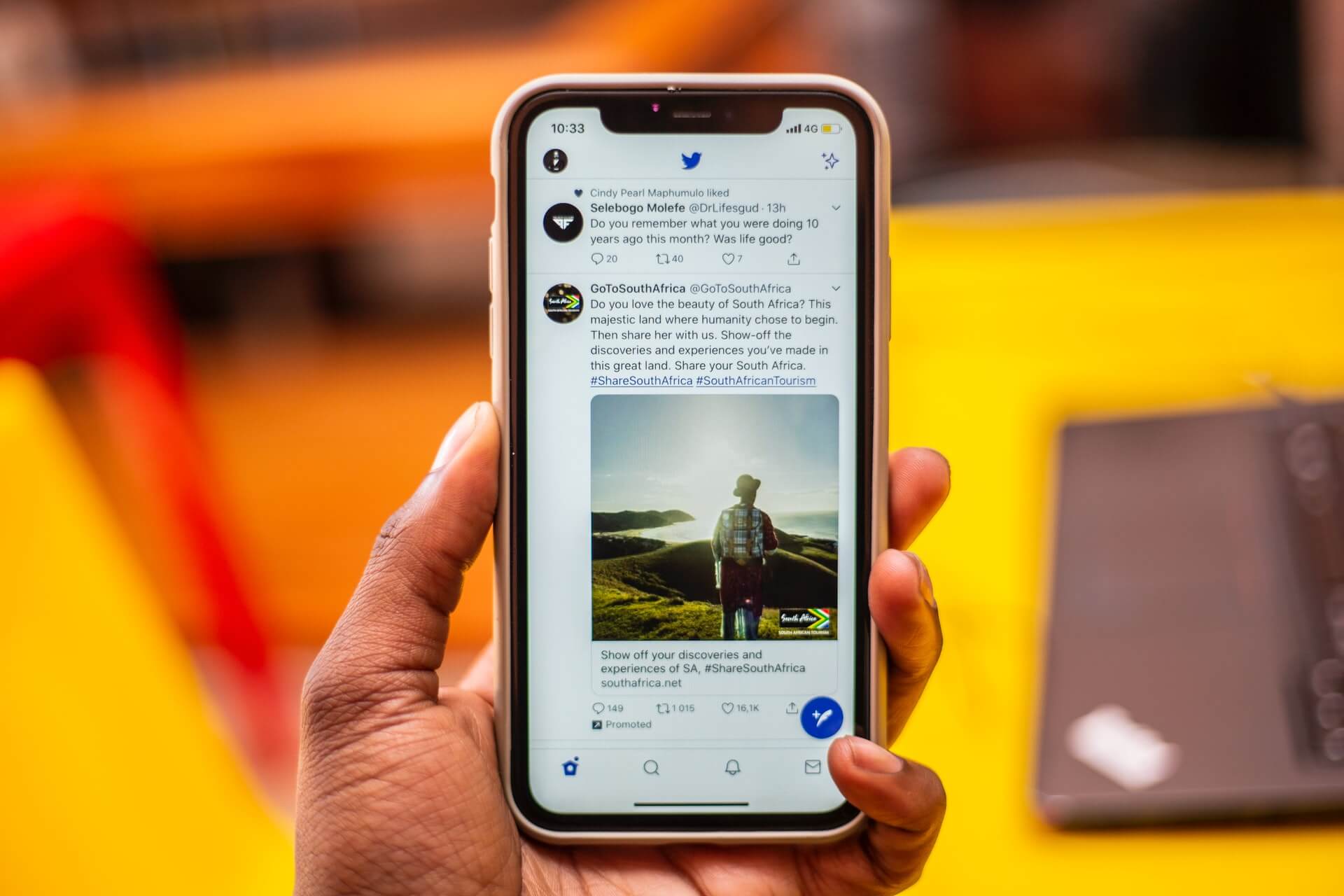
How to find and engage your target audience on Twitter

Twitter is a prime platform for engaging with audiences more authentically and creating strong customer relationships. You may be ready to start marketing on Twitter but feel unsure of how to find the right audience.
So, how do you find the people ready to engage with your brand? And how do you reach them on the platform?
In this article, we’ll talk about key demographics you need to know to understand who’s on Twitter and find your target audience on the platform. We’ll also share actionable tips for reaching your ideal market on Twitter.
Top Tip: A marketing plan that sparks engagement and boosts sales has to involve talking to consumers where they are. Learn to reach your audiences on popular social media platforms in our guide on creating a digital marketing strategy💡
Table of contents
- How to find your audience on Twitter
- Using Twitter Ads to reach the right people at the right time
- How to actively engage your Twitter audience
- Connect with Twitter audiences who are ready to hear from you
How to find your audience on Twitter
In 2022, Twitter reported 229 million global monetisable daily active users (mDAU)—in other words, 229 million daily users who see ads. If you want to improve your Twitter marketing efforts and engage some of those potential customers, you need to know who’s on the platform and which Twitter users fit your target audience.
To determine who your brand can access out of that active group, you can look at Twitter user demographics. This is the data around what drives Twitter, including how and why people use the platform.
These demographics tend to shift over time, so It’s important to check in on Twitter statistics regularly to be aware of changes that could affect your digital marketing strategy.
As the number of users on Twitter grows, the range of demographics engaging on the network also shifts. Know who’s on the platform currently and stay on top of changes to how they’re using it to figure out which users fit into your target audience. Watch for changes to take advantage of opportunities to reach new audiences.
Top Tip: Not every social network attracts the same demographics, and it can be useful to be on multiple platforms to get the most out of your marketing strategies. Learn everything you need to know to spread your message on another key social platform in our guide on Instagram marketing for business 📱
Top Twitter demographics you should know to make your marketing more effective
A focus on relevant Twitter demographics should be part of your target audience research. These statistics tell you who’s using the platform and will be foundational to your marketing strategy.
Here are a few of the top demographics to be aware of now (and to track going forward):
- Location. Location can be critical to your marketing efforts if you only offer your products or services in certain parts of the world. You need to know if you have a big enough audience in those regions to market to.
For instance, 2022 data analysis shows that the countries with the largest Twitter advertising audiences include the US, Japan, India, Brazil and Indonesia. The UK ranks sixth on the list. This is a change from previous years when the UK ranked third, followed by Saudi Arabia. Know where your audience is and where it’s growing.
- Age. Learn what age groups you’re most likely to engage on Twitter, so you know if it’s a useful platform for your campaign.
Twitter emerged as millennials (currently between 26 and 41 years old) were coming of age, and this group still represents the biggest source of Twitter usage globally. Nearly 60% of Twitter users were between 25 and 49 years old as of April 2021. And over 80% of users are under the age of 60.
Twitter audiences tend to be younger, so if your target age range is mostly nearing retirement, you may need to opt for another platform.
- Gender. When it comes to gender targeting, it’s important to know who’s on Twitter but also how they use the platform.
For instance, let’s take men and women, for example. In the US, users skew male. But according to a survey by the Pew Research Center, women are much more prolific tweeters.
Understanding how your audience uses the platform (in this case, how different genders interact with it) can help you target content to those behaviours.
- Income. Twitter users, as with other social media users, tend to be more affluent than the general population. According to research from 2018, 60% of Twitter users in the UK earn over £48,000 per year. At the time, the average annual income was £28,400.
An audience with more disposable income may be concerned with particular product characteristics. Depending on your research, you may want to align your marketing strategy to focus on brand reputation, for example, rather than price to capture their attention.
- Education. Twitter has one of the most highly educated audiences of all social media platforms, with 42% having a college degree or higher.
These audiences may be slightly more accustomed to analysing marketing, and you’ll once again want to focus your campaign on quality and establishing a strong brand reputation.
- Language. Data analysis in 2018 revealed the most popular languages used on Twitter are English (31.8%), Japanese (18.8%), and Spanish (8.46%).
Depending on where your target market is, you’ll want to be able to advertise to them in the language they are most familiar with. You may also find that advertising in multiple languages is useful if you’re marketing to an area with a large multicultural audience.
Observing different key demographics helps you see what your customers (and potential customers) are looking for and what Twitter campaigns influence their buying decisions and behaviour. Take a look at your own account using Twitter Analytics to find metrics about your followers.
When you can compare your account’s follower data to information about general Twitter users in your target markets, you can make more informed marketing decisions. For instance, it can help you decide whether to continue with current marketing tactics and what potential audiences you should be reaching out to.
Top Tip: Once you find your target audience, you need to know how to put the right message in front of them and lead them through the sales funnel. Learn how to plan out your customers’ journey in our guide on how to build a go-to-market strategy🥇
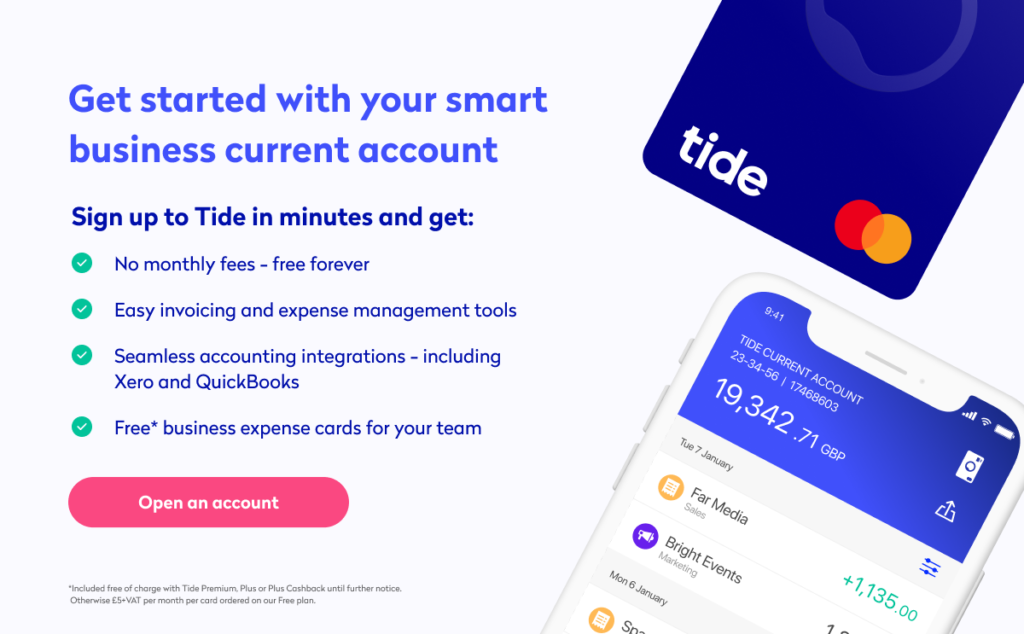

Using Twitter Ads to reach the right people at the right time
Twitter makes it easy to reach out to specific groups with targeting tools that deliver your ads directly to the people you want to see them. Here’s an overview of the tools available when you opt for paid advertising on Twitter.
Location targeting
You can target your ads to show up in front of users in the countries, regions, cities or postal codes most relevant to your brand. Choose your locations from the many offered in your campaign setup. Your ads will be visible to every geo location you select.
Location targeting is useful if your service is only available in certain areas, or if you want to set up specific landing pages for different regions to access. It can also be a great way to run a campaign that takes advantage of local events, for instance, a highly publicised sporting event.
Check out this ad the city of Santa Clara, California, created to show up in the feeds of users in the area for Super Bowl 50 in 2016:

The ad takes advantage of timing and location to get a very specific message in front of its audience.
Language targeting
Looking to speak to an audience in their native language? Twitter considers a user’s language settings as well as a number of other signals to determine their language(s). You can choose to target your ads in any of 46 different languages to get them in front of the right users.
Language targeting is helpful if you’re running campaigns in different countries and want to send users to a landing page in their preferred language.
Device targeting
Twitter’s users are generally tech-savvy, and you can sort them by the device, operating system or even by the carrier they use in their social interactions.
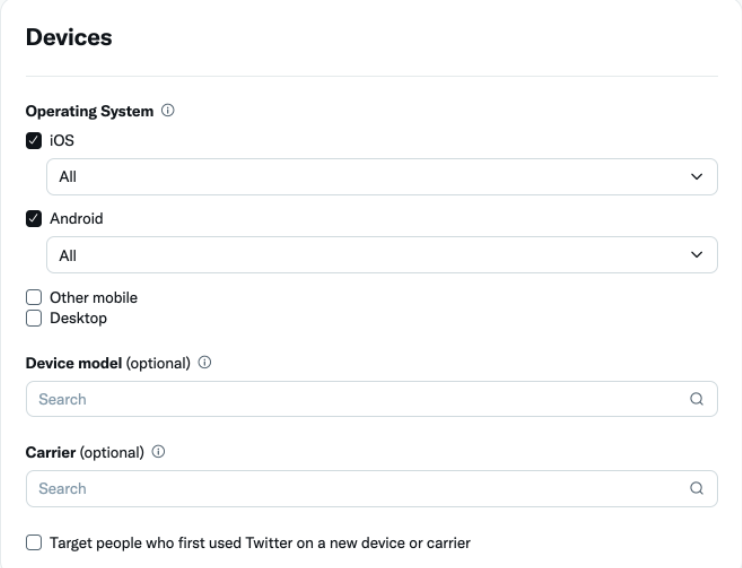
Device targeting is useful if you have an app or service that only applies to new devices or OS versions. You can use the options to exclude people who wouldn’t find your ad relevant or who wouldn’t be able to take advantage of your offer because of device limitations.
Age targeting
You can choose the age segments you want to get your campaign in front of and tailor your ads to speak to experience.
Twitter uses birthdates users report to categorise them by age. The platform also looks at attributes of those who don’t report a birthdate to infer age (tracking things like Twitter accounts they follow and general interests) and takes them into consideration when sending out your ad.
Gender targeting
As with age targeting, Twitter sorts users by the gender they report. For those who don’t manually enter a gender, Twitter again makes inferences based on interests and behaviours on the platform to categorise users.
Age and gender targeting are not generally used alone, but can refine your marketing efforts as you group them with other demographics such as location and keywords.
Conversation targeting
You may want to target users based on the conversations they actively participate in online. You can choose from a list of over 10,000 conversation topics across 25 categories (including lifestyle, sports, health and wellness, gaming and more).
You can use conversation targeting to find the audiences who will relate to your ad content by joining discussions already in progress.
Keyword targeting
Keyword targeting lets you reach people with (or exclude them from) your campaign based on their recent searches, phrases they’ve tweeted or tweets they’ve engaged with.
Simply fill out keywords you want to target while setting up your ad campaign. You’ll be shown a volume estimate that lets you know how popular the keyword is by daily volume.

When you know you’re offering a topic people are already interested in, you’ll have more success engaging them and driving conversions. Choosing general keywords will get you a broader audience while making them more specific will reach a smaller audience but might drive more engagement.
Follower targeting (and follower look-alikes targeting)
You already know your followers are interested in your brand and what you have to say, so include them automatically in your ad campaigns. You can also add the followers of accounts similar to yours to a campaign.
Do your research to understand your competitors and key influencers in your industry. Then add their account followers to your campaign.
Rather than targeting accounts with millions of followers, pay attention to those who seem most relevant to your brand and your own following.
You can also target follower “look-alikes”. Select this option to use Twitter’s algorithm to find users with similar attributes as the followers you’re targeting. It will sort people by their tweets, replies and other activities.
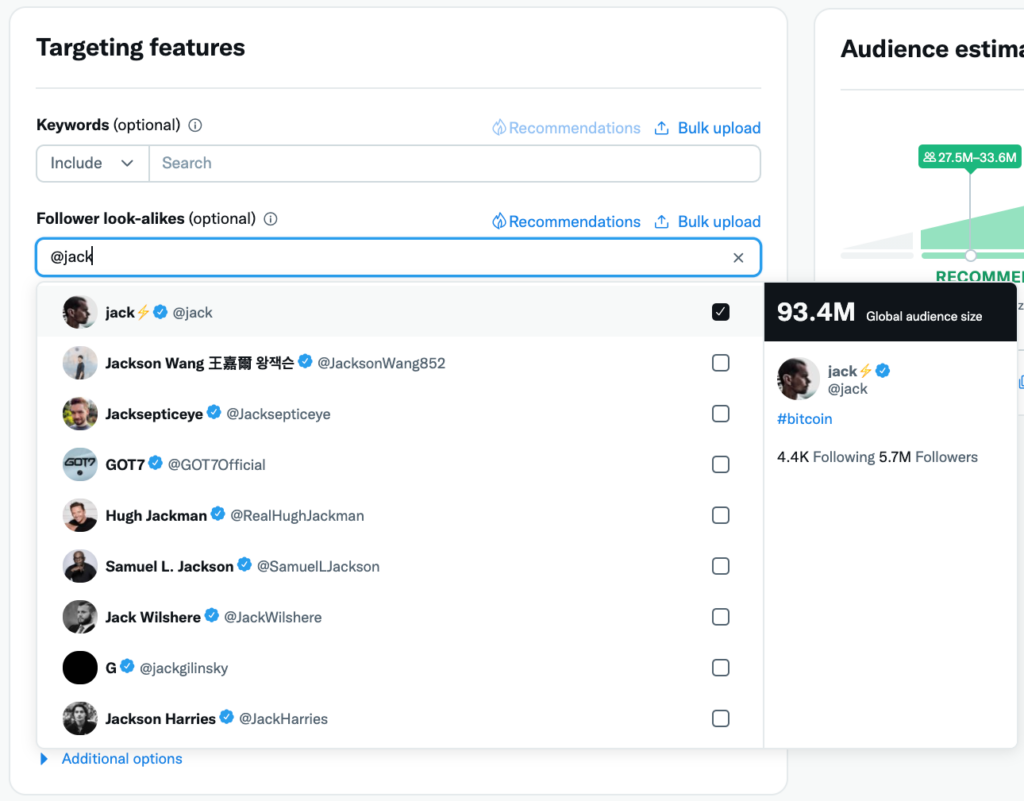
Target accounts that are closely aligned to your brand’s offering versus just choosing accounts with a high volume of followers. Not everyone who follows a celebrity, for instance, comes to the account for a reason relevant to your business.
Follower look-alikes targeting is a great way to expand your audience with confidence that they’ve already expressed interest in the types of products or services you offer.
Top Tip: Successful ad campaigns on any social platform, whether you’re talking about Twitter, LinkedIn or TikTok, require a strategy. Learn to build a tailored content plan in our guide on how to create a social media marketing strategy for your small business 💯
How to actively engage your Twitter audience
Outside of running paid ads, you can and should be active on your Twitter timelines. Use your account to engage and build your audience organically.
Make your brand visible by remembering the core purpose of Twitter: it’s a social platform. People come to it expecting to converse and interact. You can’t expect to build a following with one-way communication alone.
Here are four strategies for engaging your target audience on Twitter by taking advantage of the social nature of the platform.
Top Tip: Advertising is just one of the ways you can use social media to grow your business. Learn additional ways to boost your brand online in our guide on how to use social media to grow your business 🔬
1. Create custom lists to engage with followers more efficiently
Group and sort your followers and potential followers into curated custom audiences. This will make it easier to follow and respond to pertinent conversations, questions or mentions while they’re still relevant.
You can create Twitter lists from your profile and populate them with related accounts. Create different lists for different groups. For instance, you might create one for active customers, one for industry influencers and one for competitors. Twitter will then organise your lists into chronological feeds that are easier to keep up with.
You can make these lists public, so others can subscribe to them, or keep them private as you use them for gathering industry knowledge. You can also subscribe to lists others have already curated to find ways to be more active more quickly.
For instance, Case Study Buddy founder Joel Klettke has curated several lists relevant to his company’s niche that are public for others interested in content marketing to view.

Make the most of your lists by uploading them into the Audience tool in your Twitter Ads account. Then you can use them to target a specific group with a relevant campaign.
2. Do account comparisons to see what’s working for competitors
Keeping up with your competitors and their activity can help you learn new ways to reach your audience. Study what others are doing as well as the success they’re having and look for gaps you can fill.
You can take this a step further by digging into the stats on competitors’ Twitter accounts. Third-party tools like Audiense can help you get and analyse insights on how they’re performing and who they’re attracting.
The Audiense Account Comparison tool looks at data around an account’s followers, tweets per day, noted interests and other activity on the platform.
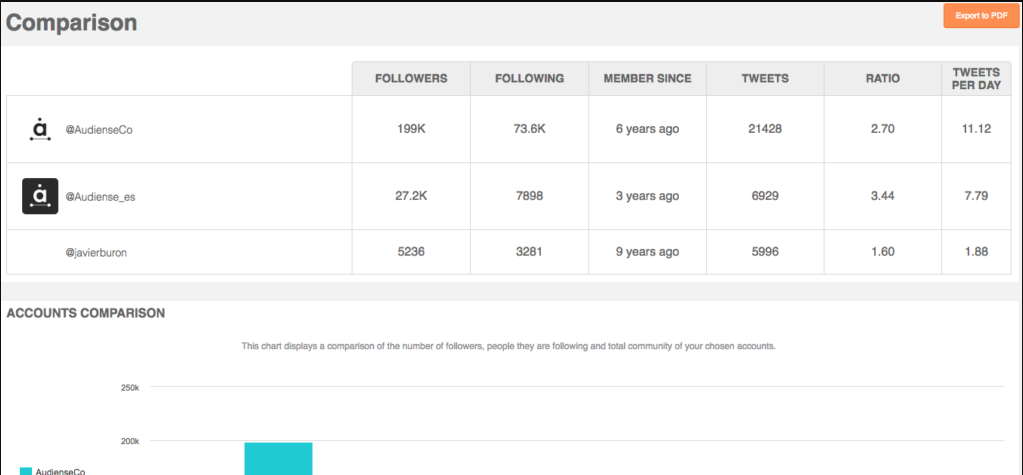
Seeing these metrics side by side with your own can help you find new audience segments and best practices for keeping engagement strong.
3. Target industry influencers to expand your reach
As with other social networks, influencers on Twitter can help you amplify your message and reach a wider audience. Influencers have created big followings and built trust with their followers. Getting them involved with your messaging builds social proof that reassures consumers.
Curate lists of influencers to follow and engage with. You can also use those lists to target ads directly to influencers and get them tweeting about your brand.
For instance, if your company has done original research, publish the findings (with a link) in a tweet that gets in front of industry influencers. If they find it interesting and useful, they’ll retweet the info with commentary. You’ll get more eyes on your research and on your brand.
Top Tip: Getting influencers to engage with and promote your brand is a powerful way to build social proof. You can also turn your customer base into brand ambassadors by creating a brand that appeals to your target market. Learn how in our guide on how to build a brand that customers love 😍
4. Join relevant conversations to increase engagement
The point of curating lists and audiences is to find the right consumer base to market to. Twitter is an interactive platform; to maintain traction, you’ll need to engage with your audience once you’ve found them.
Here are a few best practices to keep in mind:
- Jump into conversations you can contribute to and learn from.
- Keep yourself front of mind by using hashtags to attract interaction.
- Participate in or host a regular weekly or monthly Twitter chat on a given topic. Run it like an event and advertise the time and hashtag in advance.
- Answer questions and respond to mentions or brand-specific hashtags.
- Make sure someone is monitoring your DMs to reply quickly.
Being active on your Twitter account will help you stay in front of your target audience and build strong customer relationships.
Top Tip: Ready to strengthen your online marketing efforts by engaging with audiences on multiple social platforms? Get started on another top social platform with our beginners guide on 10 tips for small businesses to get started on Instagram 📌
Connect with Twitter audiences who are ready to hear from you
Getting your message in front of the right audience is key to any marketing success. Targeting your audience on Twitter is an important way of getting more engagement and, ultimately, more conversions and sales.
Do your research to find out who your brand can reach on the platform. Then deploy the many tools and strategies that will help you get in front of the right people to have an impact.


Photo by Daddy Mohlala, published on Unsplash




